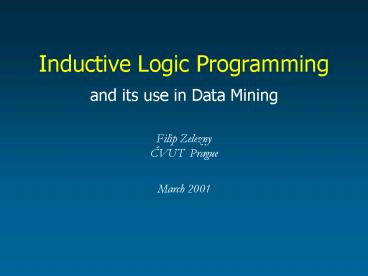Inductive Logic Programming - PowerPoint PPT Presentation
1 / 29
Title:
Inductive Logic Programming
Description:
Table of cars: Predict the attribute affordable ' ! Rule discovered: ... size=small & luxury=low affordable. Data Mining Example 2 (1) [L. De Raedt, 2000] ... – PowerPoint PPT presentation
Number of Views:33
Avg rating:3.0/5.0
Title: Inductive Logic Programming
1
Inductive Logic Programming
- and its use in Data Mining
- Filip ZeleznyCVUT Prague
- March 2001
2
Structure of Talk
- Motivation, ILP Concept
- Basic Technique
- Some Applications
- Novel Approaches
- Conclusions
3
Points of View
- Software Engineering View
- ILP synthesizes logic programs from examples
- ... but the programs may be used for data
classification ... - Machine Learning View
- ILP develops theories about data using predicate
logic - ... but the theories are as expressive as
algorithms (Turing machine) ...
4
A Motivation
5
Data Mining Example 1
- Table of cars
- Predict the attribute affordable !
- Rule discovered
- Attribute learning is appropriate.
- sizesmall luxurylow ? affordable
6
Data Mining Example 2 (1)L. De Raedt, 2000
- Positive Examples
- Negative Examples
7
Data Mining Example 2 (2)L. De Raedt, 2000
- How to represent in AVL?
- Assume fixed number of objects
- Problem 1 exchange objects 1 2
- exponential number of different representations
for the same entity
8
Data Mining Example 2 (3)L. De Raedt, 2000
- Problem 2 Positional relations
- explosion of false atributes
- Problem 3 Variable number of objects
- explosion of empty fields
- explosion of entire table
- We need a more powerful representation!
9
The language of Prolog
10
The Language of Prolog- Informal Introduction (1)
- Ground facts (Predicate w. constants)
- add(1,1,2).
- Variables
- add(X,0,X).
- Functions
- e.g. s(X) - successor of X
- Rules (implications)
- add(s(X),Y,s(Z)) ? add(X,Y,Z).add(0,X,X).
11
The Language of Prolog- Informal Introduction (2)
- Invertibility
- minus(A,B,C) ? add(B,C,A).
- Functions can be avoided (flattening)
- suc(X,Y) ? X is Y-1. (built-in arithmetics)
- add(0,X,X).
- add(X,Y,Z) ? suc(A,X) suc(B,Z) add(A,Y,B).
12
The ILP Concept
13
Deduction (in Logic Programming)
Apriori (background) knowledge about integers
Theory (hypothesis) about addition
suc(X,Y) ? X is Y-1.
add(0,X,X). add(X,Y,Z) ? suc(A,X) suc(B,Z)
add(A,Y,B).
add(1,3,5), add(8,7,6), add(1,1,1), ...
add(1,1,2), add(3,5,8), add(4,1,5), ...
Positive examples of addition
Negative examples of addition
14
Induction(in Inductive Logic Programming)
Apriori (background) knowledge about integers
Positive and negative examples of addition
add(1,1,2), add(3,5,8), add(4,1,5), ...
suc(X,Y) ? X is Y-1.
add(1,3,5), add(8,7,6), add(1,1,1), ...
add(0,X,X). add(X,Y,Z) ? suc(A,X) suc(B,Z)
add(A,Y,B).
Theory (hypothesis) about addition
15
Basic ILP Technique (1)
- Search through a clause implication lattice
- From general to specific (top-down)
- From specific to general (bottom-up)
add(X,Y,Z)
add(X,Y,Z) ? suc(A,X)
add(X,Y,Z) ? suc(B,Z)
add(X,Y,Z) ? suc(A,X), suc(B,X) ... etc.
add(X,Y,Z) ? suc(A,X) suc(B,Z) add(A,Y,B)
16
Basic ILP Technique (2)
- Clauses usually constructed one-by-one
- e.g. specialize until covers no negatives,then
begin a new clause for the rest of positives - Implication is undecidable
- instead use syntactic. subsumtion (NP - hard)
- measure generality of clause with background
knowledge - Efficiency use strong bias!
- syntactical
- indicate input/output vars maximum clause length
- semantical e.g. preference heuristics
17
Applications
18
Protein Structure Prediction(1) Muggleton, 1992
- Predict the secondary structure of protein
- examples
- alpha(Protein, Position). - residue at Position
in Protein is in alpha helix. - negatives all other residues
- background knowledge
- position(Protein, Pos, Residue)
- chem. properties of Residues
- basic arithmetics
- etc.
19
Protein Structure Prediction(2) Muggleton, 1992
- Results
- added to background knowledge, then 2nd search
- again added to B for the 3rd search
alpha0(A,B) ? ... position(A,D,O)
not_aromatic(O) small_or_polar(O)
position(A,B,C) very_hydrophobic(C)
not_aromatic(C) ...etc (22 literals)
alpha1(A,B) ? oct(D,E,F,G,B,H,I,J,K)
alpha0(A,F) alpha0(A,G).
alpha2(A,B) ? oct(C,D,E,F,B,G,H,I,J)
alpha1(A,B) alpha1(A,G) alpha1(A,H).
20
Protein Structure Prediction(3) Muggleton, 1992
- Final accuracy on testing set 81
- Best previous result (neural net) 76
- General-purpose bottom-up ILP system Golem used.
- Experiment published in the Protein
Engineering journal.
21
Mutagenecity PredictionSrinivasan, 1995
- Predict mutagenecity (carcinogenecity) of
chemicals with general system Progol Muggleton - Examples compounds
- Active Inactive
- Result structural alert
22
Datamining in TelephonyZelezny et al, 2000
- Discover frequent patterns of operations in an
enterprise telephone exchange - Examples history of calls related attributes
- Result e.g. rule (lower case constant)
- covers
- Predicates day, prefix, etc. in background
knowledge.
redirection(A,B,C,10) ? day(tuesday,A)
prefix(C,5,0,2).
redirection(15, 13,14,48, 5,0,0,0,0,0,0,0,
10). redirection(15, 14,18,58,
5,0,9,6,0,1,8,9, 10). redirection(22,
18,50,30, 5,0,0,0,0,0,0,0, 10).
redirection(29, 13,35,56, 5,0,0,0,0,0,0,0,
10). redirection(29, 13,57,36,
5,0,0,0,0,0,0,0, 10).
23
Other Applications
- Finite element mesh design
- Control of dynamical systems
- qualitative simulation
- Software Engineering
- Many more, especially in data mining
24
Novel Approaches
25
Descriptive ILP
- Examples are interpretations (models)
- is one example
- Hypothesis must be true in all examples
- Suited for data mining
- finds ALL true hypothesis - maximum
characterisation
triangle(t,up) circle(c1) inside(c,t)
circle(c2) right_of (c2,t) class(positive)
class(positive) ? triangle(X,Y) circle(Z)
inside(Z,X).
26
Upgrades of Propositional Learnes1st-order
Decision Trees
- Upgrades the C4.5 algorithm
- E.g. Tilde Blockheel, De Raedt
? - circle(C1)
? - triangle(T,up) inside(C1,T)
class(positive)
? - circle(C2) inside(C1,C2)
class(positive)
class(positive)
class(negative)
27
More Upgrades of Propositional Learners
- 1st-order association rules
- the WARMR system Dehaspe
- upgrade of Apriori
- 1st-order Bayesian Nets
- 1st-order Clustering
- 1st-order Distance Based Learning
28
Concluding Remarks
- Advantages of ILP
- Theoretical Turing-equivalent expressive power
- Practical rich but understandable language,
integration of background knowledge,
MULTI-relational data mining - Problems still to be solved...
- efficiency, handling numbers, user interfaces
29
http//cyber.felk.cvut.cz/ACAI01































